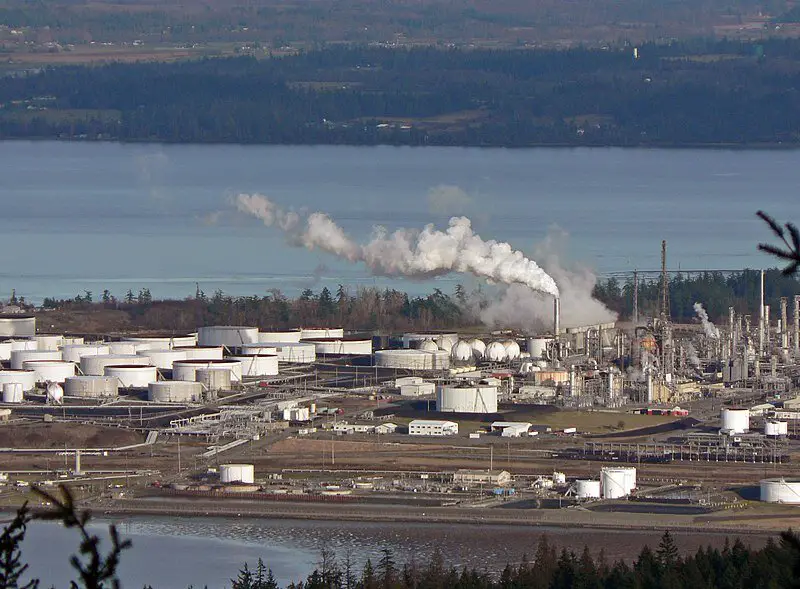5 Sources of Thermal Pollution and Their Characteristics Explained
Sources of thermal pollution are; solar radiation, power plants, industrial manufacturing facilities, refineries, and stormwater management systems.
This article discusses the sources of thermal pollution and their characteristics, as follows;
1). Solar Radiation (as one of the Sources of Thermal Pollution)
Solar radiation is the most common natural source of thermal pollution.
It is a potent source because electromagnetic rays from the Sun comprise of thermal energy, along with light [1]. On contact with a given medium or environmental system, this thermal energy can be absorbed and circulated through a radiative and convective mechanism of heat-energy transfer.
The role of solar radiation as a cause of thermal pollution, is most pronounced in natural ecosystems like forests and grasslands; because these tend to have higher degrees of exposure to the elements, than human-modified urban areas.
In fact, one of the core examples of thermal pollution is caused by solar radiation, where soil and water bodies become more exposed to the Sun as a result of ecology-altering events like deforestation.
The main subjects of thermal pollution by solar radiation are aquatic ecosystems; including freshwater bodies like lakes and ponds; and marine biomes like the ocean.
These ecosystems are susceptible due to the relatively-high conductivity and energy-storage capacity of water, which allow it to absorb and retain large amounts of heat in short periods of time, with a fair degree of efficiency.
It must be noted that the effects of thermal pollution by solar radiation are not as severe as those caused by other thermal sources.
Solar radiation is not the main source of thermal pollution, as this position can be given to manmade sources like industrial facilities.
However, it (solar radiation) can still have drastic effects on both abiotic and biotic components of the ecosystem.
Some examples of these potential effects are; reduction of dissolved oxygen concentrations, toxin potency increase; and decline in species richness and biodiversity.
Solar radiation is not the only natural source of thermal pollution. Others include volcanoes, geothermal reservoirs, and natural hazards like wildfires.
2). Power Plants
Another notable source of thermal pollution is power plants.
Basically, these are industrial facilities that are equipped to perform electricity generation as a sole function. The role of power plants in thermal pollution can be attributed to the fact that the process of generating electricity often involved significant production and conversion of thermal energy.
There are multiple means by which power plants can cause not only thermal pollution, but also water, land and air pollutions respectively. One of these is the combustion of energy resources like coal and gasoline to produce heat and pressure for electricity generation.
In the process of combustion, these fuels may release toxic byproducts and greenhouse gases that induce climate change and degrade air quality [4].
Environmental degradation hazards like oil spills, toxic wastewater and heavy metal accumulation may also occur within the context of power plant operations, and can degrade both soil and water.
Power plants are the largest contributors to thermal pollution in developed countries like the United States, where power generation occurs on a large and continuous scale [2].
This can be explained by the immense magnitude of thermal waste energy released by power plants, mostly carried by wastewater that has been used as a coolant for combustion engines, gas chambers and turbines.
In the absence of effective solutions to thermal pollution like recycling and cooling, large volumes of hot (or warm) wastewater are usually discharged from power plants into water bodies and soils, so that these media become thermally polluted and lose their ecologic integrity.
As earlier stated, heat is not the only pollutant produced by power plants. Pollutants from power plants include nitrogen oxides, sulfur dioxide, heavy metals and particulate matter.
The dangerous potency of power plants as sources of thermal pollution is also caused by the remote location and size of these plants, which places them in proximity with natural ecosystems including water bodies, where thermal waste is dumped.

3). Industrial Manufacturing Facilities (as one of the Sources of Thermal Pollution)
In general, the industrial sources of thermal pollution include; nuclear power plants, fossil fuel plants, renewable energy systems like hydro energy and biomass power plants, as well as manufacturing facilities.
Industrial effluents can cause thermal pollution because they usually contain significant quantity of heat itself, and/or organic and inorganic contaminants that produce heat through their reactions.
For manufacturing facilities, the effluents produced include coolant fluid and wastewater carrying byproducts of raw material-processing.
It must be noted that many, if not most, processes in manufacturing produce heat, either by friction, thermoelectrical conversion, or combustion. This heat, when allowed to escape into the external environment, can cause thermal pollution.
Possible measures to mitigate such environmental issues related to manufacturing include heat energy conservation, and energy efficiency-optimization for machines.
4). Refineries
Like power plants, and manufacturing facilities, refineries are potential (industrial) sources of thermal pollution.
This includes petroleum refineries and biorefineries, among other types.
Studies also show that olive oil-extraction refineries are potential causes of thermal pollution [3].
In terms of operation, refineries are similar to power plants in that they depend on heat for many aspects of the refining process, such as cracking and distillation. Waste heat from these facilities is what causes thermal pollution, when it is improperly disposed of.
Many refineries also have a large carbon footprint, and are responsible for global warming due to the release of carbon dioxide and sulfuric oxides as raw energy resources are broken down and transformed to refined products.

5). Stormwater Management Systems (as one of the Sources of Thermal Pollution)
Stormwater management systems become sources of thermal management when their capacity is exceeded, and/or they are inadequately managed.
Thermal pollution by urban stormwater is the influx of heat alongside flowing water from precipitation events like rain.
These precipitation events are particularly effective at forming stormwater in areas where urbanization has led to the building of pavements that cover the soil and reduce permeability of ground surfaces, so that large volumes of rainwater are able to form in relatively short periods of time, without percolating into the soil.
Cases of thermal pollution from stormwater management systems are often multi-dimensional; involving various forms of degradation that include stormwater pollution, land pollution and regional water pollution.
This is because stormwater transports and deposits foreign materials as it flows, and may deposit some of these pollutants in water bodies along with its (that is; the stormwater's) heat content.
Thermal pollution by stormwater is often harmful to aquatic organisms like fish, as it affects their oxygen and nutrient supplies, and threatens their survival [5].
Conclusion
Sources of thermal pollution are;
1. Solar Radiation
2. Power Plants
3. Industrial Manufacturing Facilities
4. Refineries
5. Stormwater Management Systems
References
1). Du, Y.; Le, N. C. H.; Chen, H.; Zhu, Y. (2016). "Thermal management of solar cells using a nano-coated heat pipe plate: An indoor experimental study." International Journal of Energy Research 41(6). Available at: https://doi.org/10.1002/er.3678. (Accessed 18 May 2023).
2). Edward, L. A. (2017). "Aquatic Pollution: An Introductory Text (4th ed.)." Hoboken, NJ: John Wiley & Sons. ISBN 9781119304500. Available at: https://books.google.com.ng/books?id=V5D2DQAAQBAJ&redir_esc=y. (Accessed 18 May 2023).
3). Frölén Ribeiro, L.; Aguilera, O.A.; Hérnandez, Z. (2021). "Thermal Pollution Mitigation and Energy Harnessing of the Condensation Process of an Olive Oil Extraction Refinery: A Case Study." Environments 2021, 8, 84. Available at: https://doi.org/10.3390/environments8080084. (Accessed 18 May 2023).
4). Perera F. (2017). "Pollution from Fossil-Fuel Combustion is the Leading Environmental Threat to Global Pediatric Health and Equity: Solutions Exist." Int J Environ Res Public Health. 2017 Dec 23;15(1):16. Available at: https://doi.org/10.3390/ijerph15010016. (Accessed 18 May 2023).
5). Simpson, M.; Winston, R. J. (2022). "Effects of land use on thermal enrichment of urban stormwater and potential mitigation of runoff temperature by watershed-scale stormwater control measures." Elsevier, Ecological Engineering, Volume 184, November 2022, 106792. Available at: https://doi.org/10.1016/j.ecoleng.2022.106792. (Accessed 18 May 2023).





